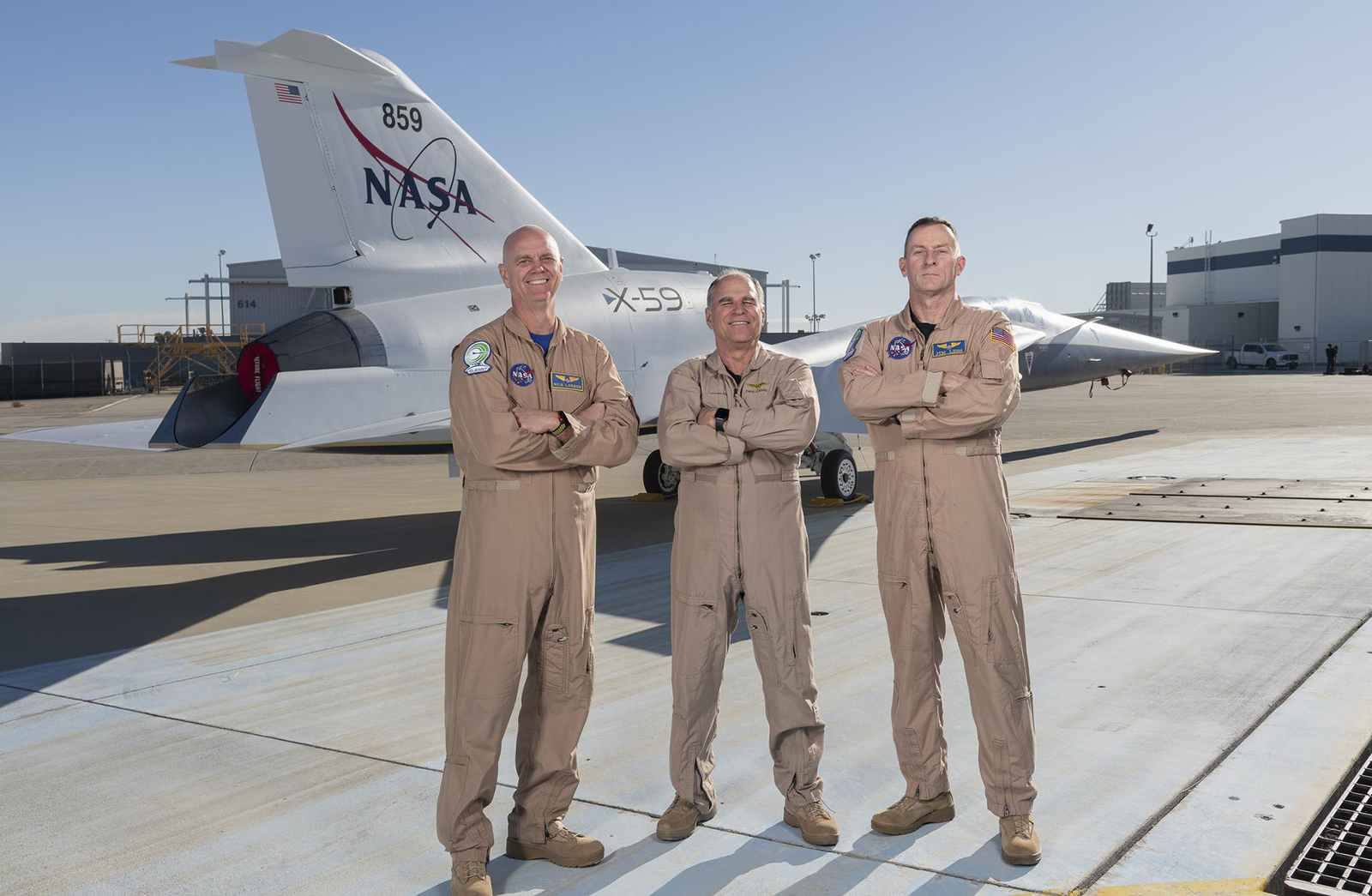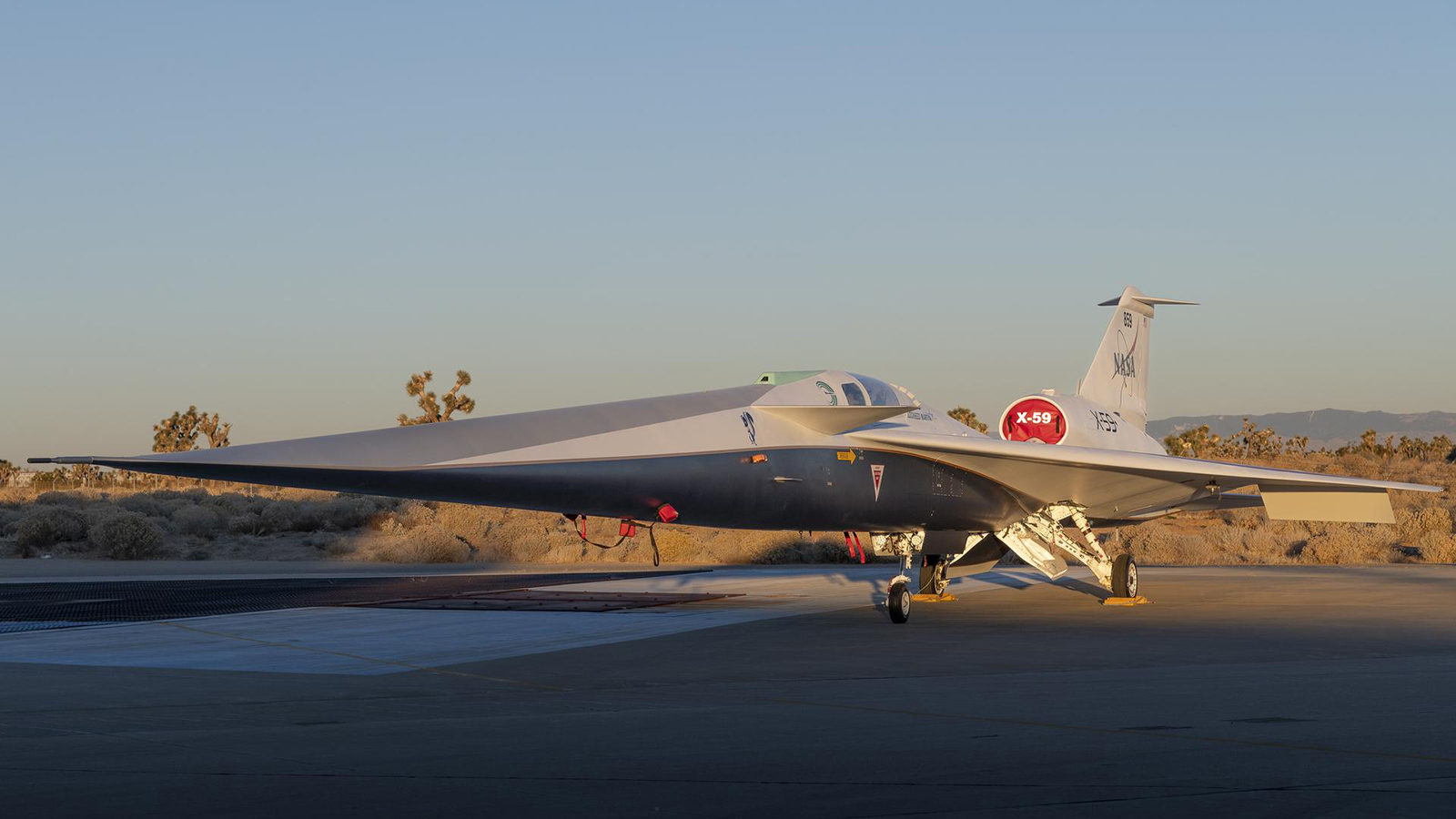Stay Up to Date
Submit your email address to receive the latest industry and Aerospace America news.
Flights of the supersonic jet could remove the noise hurdle that has dogged supersonic travel
David Nils Larson and James Less could soon be part of aviation history.
They are the NASA pilots who will fly the X-59 experimental jet over California’s Mojave Desert in a nine-month test program that will show NASA whether the single-seat jet can be flown safely over American cities to gather reactions from residents about the aircraft’s sound.
The question is whether residents will accept the sonic “thump” that the aircraft’s pointy noise and tailored aft end should, at most, produce. In 1973, years of complaints about sonic booms from military jets prompted FAA to ban civil aircraft from flying supersonically over land in the United States. For the U.S. market, the rule limited Concorde passenger jets to flying into and out of New York’s John F. Kennedy International Airport on Long Island. Supersonic advocates hope the X-59 will prompt Congress to direct FAA to lift the ban.
Before any of that can happen, the X-59 must be taken up on its inaugural flight. NASA says that should happen this year, but it has not said when. That task and the risk of that first flight will fall to Dan Canin, a test pilot for Lockheed Martin. The company’s Skunk Works division built the plane at its facility in Palmdale, California, adjacent to the U.S. Air Force Plant 42, a complex of runways and hangars where iconic aircraft were assembled or flown from, including the U-2 and SR-71 spy planes and the space shuttle orbiters.
After final checkout at Plant 42, plans call for Canin to take the X-59 up on an initial, subsonic flight to prove its handling, followed by more flights to prove its acceptability to NASA. Ultimately, Canin or another pilot will deliver the aircraft to NASA by landing it at the nearby Edwards Air Force Base, home to NASA’s Armstrong Flight Research Center, where Larson and Less will take turns flying it over the nearby FAA-designated supersonic test corridors. NASA plans to “self-certify” the aircraft for flights over four to six U.S. cities.
For World Pilots’ Day, April 26, NASA offered the opportunity for me to interview Larson and Less. Here is our discussion, lightly edited and condensed.
Q: How have you prepared for the flights of this experimental plane?
Less: We’ve probably already spent more time in the stimulator than we’re going to get in the airplane. We are rehearsing all the flights we plan to take, from the initial test flights to prove the aircraft’s capability to the public demonstration flights we plan over cities to get feedback on what it sounds like. The simulator is essential to everything we’re doing.
Larson: I think I have a good 350 hours in the simulators up there, and then I think Dan Canin, Lockheed’s pilot who will do the first flight, must have at least twice as much as I do.
Q: What will the first flight be like?
Larson: It’ll be a big deal, with some type of event and probably a lot of publicity. It will occur only over Palmdale and Edwards, to prove the aircraft’s performance. The tough part is the weather. There will be a lot of conditions, winds especially, that have to be perfect.
Q: Have either of you flown a novel aircraft in early flight tests, and how much risk is involved with that?
Larson: I have, kind of. When I was in the Air Force, one of my projects was an airplane called the RU-38, which most people have never heard of. It was the Coast Guard airplane under flight test. At one point, it went back for redesign for like three years until it came out and it was called RU-38B. And we ended up treating that like a first flight. I was the co-pilot. It wasn’t nearly as unique as this [X-59] airplane is, so it was very different. But the first flights of any aircraft always have some inherent risk.
Q: Why is the plane designed for one pilot, not two?
Larson: It is built around the backseat of a T-38 [supersonic trainer], with a T-38 ejection seat. That was to save money, because then they didn’t have to do some analysis or tests for the ejection seat, which would have been millions of dollars, if not a billion. That kind of drove the whole size of the airplane.

Q: X-59 has no windows for a pilot to look out the front, so how does the camera system work?
Larson: For the first time on Tuesday [April 23], we got to strap all the way into the airplane itself rather than a simulator. And yes, there are no windows, but that is not actually something we as test pilots worry about. We are used to flying by instrument only. A big TV monitor is actually positioned so that you’re seeing the same thing we would see if there was a big window there, with live feeds coming in from cameras from the outside of the plane. There’s a lot of people interested in that eXternal Vision System, or XVS. The FAA was out here late last year and was talking to us about the potential use of this system for future aircraft. Because if you plan to build a supersonic transport, you’re going to have something like that, when it comes down to it. And even for subsonic airliners out there today, if you don’t have to account for the windscreen for the pilots, there’s a potential to eliminate that and reduce drag, to be more fuel efficient.
Q: What are the hardest things you’ve had to learn about this plane through the simulator?
Less: Everybody’s concerned about how we are going to land without being able to see out the front of the aircraft, but if the cameras work, it’s going to be a piece of cake. We can also land it without cameras working, using instruments only. In fact, just yesterday [April 25], they had us land with the main attitude indicator out, with just a tiny backup attitude indicator display. They said, “OK, let’s land with just that,” and we managed to do it. So we’ve shown in the simulator that we can still get it back on the ground, but that would only be after multiple failures.
Q: Do you feel anything in the cockpit when there’s a sonic boom? If there’s a chase plane, do those pilots feel anything?
Less: This is something that surprises everyone: No, we don’t hear it. The sonic boom that you hear on the ground is caused by the shock waves that are attached to the aircraft, and you only hear them because we drag that shock wave across you at supersonic speed. The shock wave doesn’t actually cross our ears, so we don’t get that pressure change to hear or feel anything.
Larson: We have a special probe on a chase airplane to measure the shock wave, from about 100 feet away to 300 feet away [30 to 90 meters]. And when you’re in the other airplane, you don’t hear anything, but you can feel it. You feel the shock waves pushing against the plane, which we sometimes refer to as “surfing the wave.” You get pushed around just like two boats that were kind of close to each other. It’s more significant than turbulence; you can tell you’re getting shoved around by something.
Q: Why is this plane quieter than other models? What’s the secret?
Less: There’s no fancy electronics or secret coating or anything like that. It is all about the shape. Every little bump — even antennas — every change in angle on the airplane will set off a shock wave. Those shock waves, pressure waves, are what cause the sonic boom, when they combine and travel over you on the ground. Instead of shock waves merging into a front shock and the back shock like most supersonic planes, we’re going to keep them spread out and just create a thump instead of a sharp crack.
Q: NASA has also been working on environmental sustainability. Does supersonic capability make flight more efficient, or is it just about getting to your destination a lot faster?
Less: For years, we tried to move faster and higher. But eventually, we just kind of came to the point where everybody stopped and we weren’t going places faster anymore because of, essentially, we put a speed limit based on the sound. But we have the technological capability to go faster.
Larson: This is just one of the many NASA programs looking at aviation of the future, and other programs are focused on sustainability, like the X-66. If we’re not allowed to go supersonic and study supersonic, then supersonic flight is never going to be as green as conventional flight. There’s no incentive to make supersonic flight more efficient, because we’re not allowed to do it. So we want to open that door to more study. Aviation, before the internet, was a really big thing that kind of made that world smaller. To me, supersonic travel is just one of those other ways to bring the world together.
Q: You’ve acknowledged some risk for this flight, so why do you both want to do this?
Less: It’s important, I think, to advance the state of technology. This is something new that hasn’t been done before. Everything we do in life is a risk. And I don’t think we think we’re taking a huge risk going out there. We’ve got a very large team of very smart, dedicated people on this airplane, and they’re not going to let us go until we think we understand all the potential hazards and that we think it’s safe. If we’ve done our job, nothing is going to happen. And we’re going to be prepared for those eventualities.
Larson: NASA and Lockheed are not going to let us get airborne unless this thing is safe. We’re not necessarily thrill seekers. I think we’re explorers, and I just look at this as an extension of exploration.
About paul brinkmann
Paul covers advanced air mobility, space launches and more for our website and the quarterly magazine. Paul joined us in 2022 and is based near Kennedy Space Center in Florida. He previously covered aerospace for United Press International and the Orlando Sentinel.
Related Posts
Stay Up to Date
Submit your email address to receive the latest industry and Aerospace America news.




